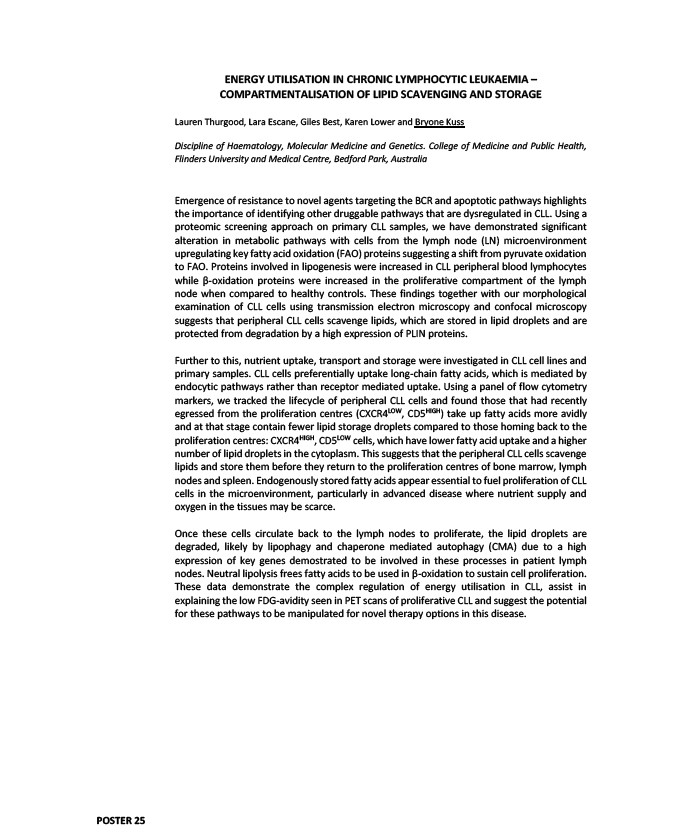
ENERGY UTILISATION IN CHRONIC LYMPHOCYTIC LEUKAEMIA –
COMPARTMENTALISATION OF LIPID SCAVENGING AND STORAGE
Lauren Thurgood, Lara Escane, Giles Best, Karen Lower and Bryone Kuss
Discipline of Haematology, Molecular Medicine and Genetics. College of Medicine and Public Health,
Flinders University and Medical Centre, Bedford Park, Australia
Emergence of resistance to novel agents targeting the BCR and apoptotic pathways highlights
the importance of identifying other druggable pathways that are dysregulated in CLL. Using a
proteomic screening approach on primary CLL samples, we have demonstrated significant
alteration in metabolic pathways with cells from the lymph node (LN) microenvironment
upregulating key fatty acid oxidation (FAO) proteins suggesting a shift from pyruvate oxidation
to FAO. Proteins involved in lipogenesis were increased in CLL peripheral blood lymphocytes
while β-oxidation proteins were increased in the proliferative compartment of the lymph
node when compared to healthy controls. These findings together with our morphological
examination of CLL cells using transmission electron microscopy and confocal microscopy
suggests that peripheral CLL cells scavenge lipids, which are stored in lipid droplets and are
protected from degradation by a high expression of PLIN proteins.
Further to this, nutrient uptake, transport and storage were investigated in CLL cell lines and
primary samples. CLL cells preferentially uptake long-chain fatty acids, which is mediated by
endocytic pathways rather than receptor mediated uptake. Using a panel of flow cytometry
markers, we tracked the lifecycle of peripheral CLL cells and found those that had recently
egressed from the proliferation centres (CXCR4LOW, CD5HIGH) take up fatty acids more avidly
and at that stage contain fewer lipid storage droplets compared to those homing back to the
proliferation centres: CXCR4HIGH, CD5LOW cells, which have lower fatty acid uptake and a higher
number of lipid droplets in the cytoplasm. This suggests that the peripheral CLL cells scavenge
lipids and store them before they return to the proliferation centres of bone marrow, lymph
nodes and spleen. Endogenously stored fatty acids appear essential to fuel proliferation of CLL
cells in the microenvironment, particularly in advanced disease where nutrient supply and
oxygen in the tissues may be scarce.
Once these cells circulate back to the lymph nodes to proliferate, the lipid droplets are
degraded, likely by lipophagy and chaperone mediated autophagy (CMA) due to a high
expression of key genes demostrated to be involved in these processes in patient lymph
nodes. Neutral lipolysis frees fatty acids to be used in β-oxidation to sustain cell proliferation.
These data demonstrate the complex regulation of energy utilisation in CLL, assist in
explaining the low FDG-avidity seen in PET scans of proliferative CLL and suggest the potential
for these pathways to be manipulated for novel therapy options in this disease.
POSTER 25